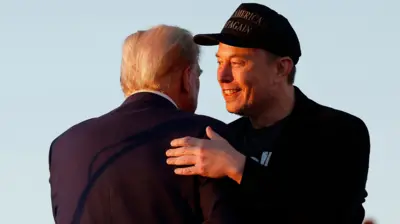We've updated our Privacy and Cookies Policy
We've made some important changes to our Privacy and Cookies Policy and we want you to know what this means for you and your data.
Viewpoint: Cancun can-do
- Author, Achim Steiner
- Role, Executive director, UN Environment Programme
In this viewpoint article, Achim Steiner, executive director of the United Nations Environment Programme (Unep), says the outcome of the Cancun climate summit reinforces moves many countries are making towards a green future.
The latest round of climate negotiations in Cancun has put the world back on track to renew international efforts to combat climate change - albeit at a pace and a scale that will leave many onlookers frustrated.
President Felipe Calderon of Mexico had urged negotiators from more than 190 countries to take control of the problem.
And on one level, this happened, in the face of the compelling and sobering reality of climate change.
The government of Mexico and the executive secretary of the UN Framework Convention must be given credit for achieving gains in a range of important areas.
These include forestry, a new Green Fund to assist developing nations, and the anchoring of the emission reduction pledges made last year in Copenhagen.
But as the UN Environment Programme and climate modellers made clear in the run up to Cancun, a significant emissions gap exists between what is being promised by countries and what is needed to keep a global temperature rise below 2C - let alone move towards the 1.5C needed to protect low lying, small island states.
Despite some gains, that gap - which under the most optimistic scenario amounts to some 5 gigatonnes (Gt) of CO2-equivalent, or the emissions of all the world's cars, buses and trucks - remains firmly in place post-Cancun.
Indeed, no-one should underestimate the magnitude of the challenge now facing South Africa, the host of next year's talks, in terms of bridging this and securing a new legally-binding agreement - let alone securing the finance needed to bring the Green Fund into operation.
Parallel lines
While the official summit struggled to a conclusion, another "summit" taking place some minutes' coach-ride from the negotiations also concluded.
This parallel summit brought together progressive heads of state, regional and local government, business and civil society.
It underlined just how far and how fast some sectors of society are now going to realise a transition to a low-carbon future and build the green- and clean-technology economies of the 21st Century.
President Calderon outlined the plans and policies which, by some estimates, are transforming his country into the fastest growing wind power market in the world.
Mexico will also phase out old, inefficient light bulbs by 2014. It has just retired 850,000 inefficient household fridges in favour of modern energy efficient ones, with millions more earmarked over the coming months and years.
Homeowners who install energy saving systems such as solar water heaters are becoming eligible for lower rate Green Mortgages.
Mexico is not alone in adopting a national strategy towards a low-carbon, resource efficient Green Economy path.
Uruguay, for example, announced a strategy to generate half of its electricity from renewables by 2015.
Sixty regional and local governments, responsible for 15% of global greenhouse gas emissions, are also moving - the Province of Quebec in Canada and the Brazilian city of Sao Paolo are aiming for cuts of 20% below 1990 levels by 2020.
Big business, from banks to airlines, is also moving. Retailer Walmart, for example, plans to cut emissions equivalent to taking 3.8 million cars off the road through measures including energy efficiency improvements at its Chinese stores.
Market moves
Even before Cancun, the world was witnessing an extraordinary mobilisation of nationally-driven projects and policies that are shifting economies onto a low-carbon path.
In Kenya, a new feed-in tariff is triggering an expansion of wind and geothermal power generation.
Indonesia is not only addressing deforestation, but will begin phasing out fossil fuel subsidies for private cars next month.
So many countries and companies are forging ahead, signalling a determination not to be held hostage by the pace of the slowest at the formal negotiation table.
It may lead some to thus wonder why time-consuming international negotiations and UN climate summits are needed at all.
The fact is that this groundswell has in large part been catalysed by the existing targets, timetables and innovative mechanisms of the UN climate treaties - not least by the momentum generated around the sometimes criticised Copenhagen Summit.
It will move even faster if a new global treaty can be put in place that not only brings certainty to carbon markets and triggers accelerated investments in clean technology, but ensures more vulnerable nations are not sidelined.
Cancun may have been a tale of two summits. The challenge now is to bring these parallel universes together in a defining and mutually re-enforcing way.
Only then will the world have a fighting chance of keeping the global temperature rise below 2C by the time the 21st Century ends, while building resilience against a changed climate.
Only then will we truly transform the energy structures of the past - and the development prospects for six billion people into the future.
Top Stories
More to explore
Most read
Content is not available








